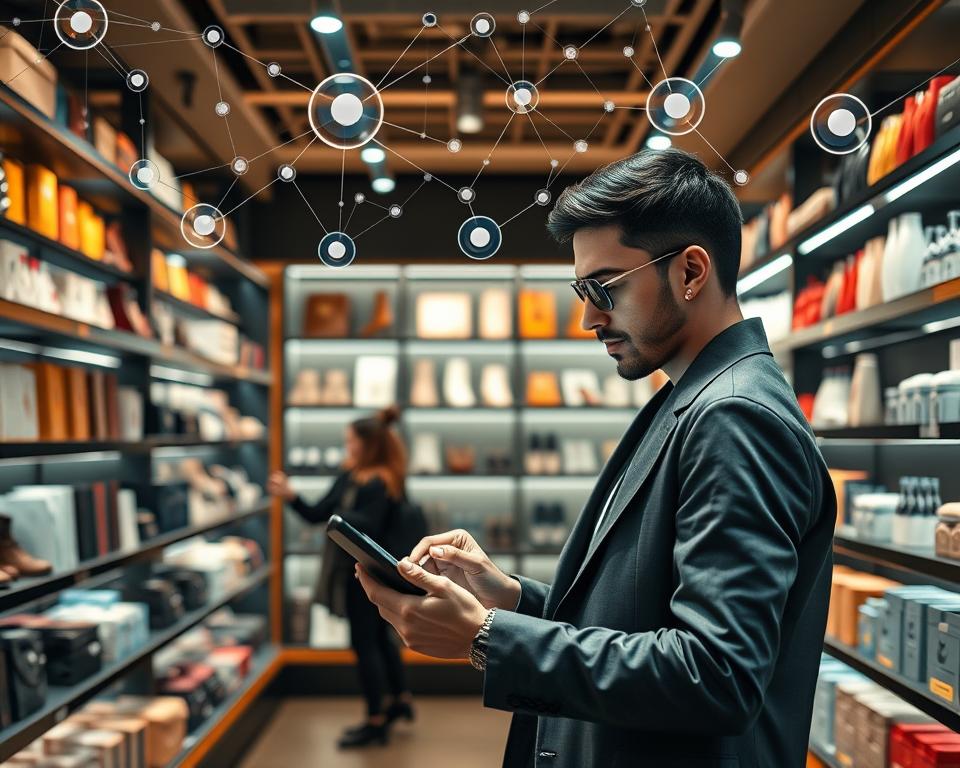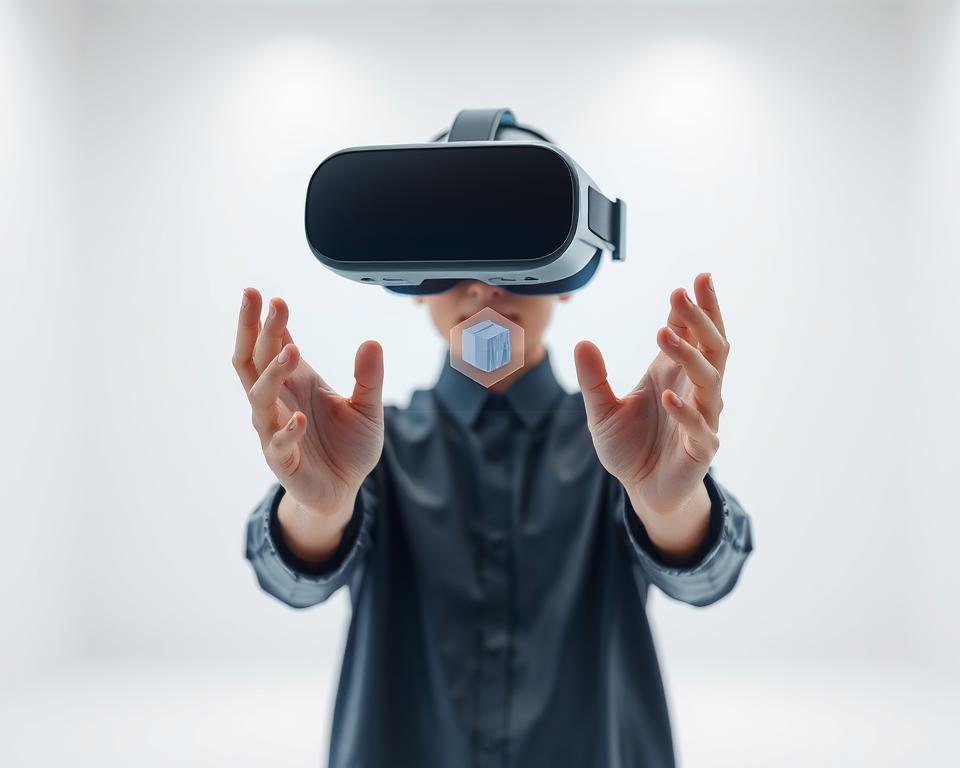The rise of AI in e-commerce and AR shopping is changing online shopping. AI helps give personalized product suggestions. AR lets customers try before they buy. These changes are making online shopping more fun and interactive.
AI and AR are making online shopping better. AI chatbots and virtual style consultants offer personalized help. AR lets customers try products before buying. These changes are shaping the future of online shopping.
Table of Contents
Introduction to AI and AR in Online Shopping
AI and AR are making online shopping smoother and more fun. They help drive sales and keep customers coming back. Many big brands are adding these technologies to their apps.
Key Takeaways
- AI in e-commerce is enabling personalized product recommendations and improving customer engagement
- AR shopping is allowing customers to try before they buy, reducing returns and increasing sales
- Online shopping trends are shifting towards a more immersive and interactive experience
- The integration of AI and AR in online shopping apps is set to revolutionize the retail industry
- AI-powered chatbots and virtual style consultants are providing personalized support to customers
- AR try-before-you-buy features are allowing customers to make more informed purchasing decisions
The Digital Shopping Revolution: Understanding AI and AR Integration
The rise of online shopping has changed how we buy things. Now, thanks to AI and AR, stores can offer a more personal and fun shopping experience. AI helps by analyzing what customers like and suggesting products just for them.
AI is great at handling lots of data fast and right. This lets stores understand what customers want and how to market to them better. AR also changes how we shop online. It lets us see how products would look in our own homes before we buy them.
Here are some ways AI and AR are used in shopping:
- Virtual try-on lets you see clothes and accessories on yourself without trying them on
- AI suggests products based on what you’ve looked at and bought before
- AR shows products in a way that feels real and interactive
The mix of AI and AR in online shopping opens up new ways for stores to connect with customers. As these technologies get better, we’ll see even more cool uses in the future.
The Current State of Online Shopping Technology
Online shopping technology has changed how we shop, with e-commerce trends always changing. Now, more people use digital tools like mobile apps and social media. The global e-commerce market is growing fast, with online sales expected to hit new records soon.
New e-commerce trends like personalized shopping and omnichannel retailing are emerging. These trends use data analytics and AI to understand what customers want. Key features of online shopping include:
- Mobile optimization
- Personalized product recommendations
- Streamlined checkout processes
- Integrated social media platforms
As online shopping tech keeps improving, we’ll see even more cool features and trends. More people will shop online, making it a big part of our lives. By keeping up with online shopping tech and e-commerce trends, businesses can meet customer needs and stay competitive.
The future of online shopping will be shaped by emerging tech like augmented reality and AI. These will help retailers create more immersive and personalized shopping experiences.
AI-Powered Personal Shopping Assistants
AI is changing online shopping, making it better with personal shopping assistants. These helpers use AI to give style tips, suggest items, and help with customer service. For example, AI-powered shopping assistants can find the perfect outfit for you by suggesting matching items and offering virtual style advice.
Some key features of AI-powered personal shopping assistants include:
- Virtual style consultants that provide personalized fashion advice
- Product recommendations engines that suggest products based on customer preferences and purchase history
- Chatbot customer service that provides instant support and answers to customer queries
These features are thanks to chatbots, AI programs that talk like humans. Chatbots help online stores offer 24/7 customer support, making shopping better.
AI-powered personal shopping assistants are transforming online shopping. They make it more personal, efficient, and fun. With AI, personal shopping assistants, and chatbots, online stores can offer a unique shopping experience that meets customer needs.
| Feature | Description |
|---|---|
| Virtual Style Consultants | Provide personalized fashion advice and recommendations |
| Product Recommendations Engines | Suggest products based on customer preferences and purchase history |
| Chatbot Customer Service | Provide instant support and answers to customer queries |
AR Try-Before-You-Buy Features
Online shopping has changed with augmented reality technology. Now, customers can virtually try-before-you-buy products. This lets them see how items look or fit without trying them on.
AR try-on has many benefits. It makes shopping more fun and personal for customers. It also helps retailers by making customers happier and more loyal. This can lead to more sales and money for the business.
Some examples of AR try-on include trying on makeup, clothes, and even furniture virtually.
Here are some key advantages of AR try-on:
- Increased customer engagement and interaction
- Improved customer satisfaction and loyalty
- Reduced returns and exchanges
- Increased sales and revenue
As technology gets better, we’ll see more cool uses of AR try-on. Customers will enjoy shopping more, and stores will make more money. It’s a win-win for everyone.
How AI & AR are Revolutionizing Online Shopping Apps Through Data Analytics
AI and AR are changing the way we shop online. They give businesses insights into what customers like. This helps make shopping more personal and fun.
For example, predictive inventory helps stores manage their stock better. This means less waste and a smoother supply chain.
Some ways data analytics help in retail include:
- Understanding what customers want to improve marketing
- Managing stock levels to avoid waste
- Creating shopping experiences that fit each customer’s taste
By using AI and AR, stores can stand out more. As tech gets better, we’ll see even more cool uses of data analytics in shopping.
The mix of AI, AR, and data analytics is making online shopping better. It offers personalized shopping, better inventory management, and smoother operations. This leads to happier customers, lower costs, and more sales. As shopping changes, businesses need to keep up with these new tools.
Virtual Fitting Rooms and Product Visualization
Online shopping is getting more popular, but trying on clothes before buying is hard. Virtual fitting rooms solve this issue. They use 3D product modeling to show how clothes fit without needing to try them on.
Stores like Gap and Levi’s use this tech. They see fewer returns and happier customers. They also offer size recommendations for the best fit.
3D Product Modeling
3D product modeling is key in virtual fitting rooms. It lets customers see a 3D version of the product. They can rotate and zoom in for more details. This tech isn’t just for clothes; it works for furniture and accessories too.
Size and Fit Recommendations
Size and fit suggestions come from the customer’s measurements. This means customers get the right fit, cutting down on returns. The system also suggests similar products in different sizes, making shopping easier.
| Benefits of Virtual Fitting Rooms | Description |
|---|---|
| Reduced Returns | Customers can try on clothes virtually, reducing the need for returns and exchanges. |
| Increased Customer Satisfaction | Customers can see how clothes would fit on them, increasing customer satisfaction and reducing the risk of returns. |
| Improved Shopping Experience | Virtual fitting rooms provide a more immersive shopping experience, allowing customers to interact with products in a more engaging way. |
AI-Driven Price Optimization and Offers
AI-driven pricing is changing the retail world. It lets businesses change prices fast, based on demand, competition, and how customers act. This method, known as dynamic pricing, helps companies make more money and stay ahead in a fast-paced market. For example, Amazon uses AI to set the best prices for its items, giving customers special deals.
Personalized offers are a big part of AI-driven pricing too. By looking at customer data and actions, companies can make offers that speak to each person. This makes shopping better and keeps customers coming back. Retailers like Walmart are using AI to give their customers special deals.
Looking at how AI helps with pricing is key. For instance, Uber changes its prices based on how busy it is. Airbnb uses AI to set the best prices for its places. These examples show how AI can help make more money and make customers happy.
Some good things about AI-driven pricing are:
- More money made through smart pricing
- Happier customers with offers just for them
- Being more competitive in a fast-changing market
Security and Privacy Considerations
Online shopping is changing fast with AI and AR. Data protection and user privacy are now top concerns. It’s crucial to keep personal data safe and follow regulatory compliance rules.
Online stores need strong data protection steps like encryption and safe storage. They should also offer user privacy options, like the chance to opt out of data collection. For more on AI in retail, check out this resource.
Key Security Measures
- Regular security audits and updates
- Employee training on data handling and security
- Incident response plans in case of a data breach
By focusing on data protection, user privacy, and regulatory compliance, online stores can gain customer trust. This ensures a safe shopping experience for everyone.
Implementation Challenges for Retailers
Retailers face many implementation challenges when adopting AI and AR. One big issue is integrating these technologies with their current systems. This can take a lot of time and effort. They also need to think about the cost of training staff and how to meet customer expectations.
Some major hurdles for retailer adoption include:
- Integrating AI and AR with existing e-commerce platforms and infrastructure
- Ensuring a seamless user experience across online and offline channels
- Providing adequate training and support for staff to effectively utilize these technologies
Experts say a good plan is key to overcoming these implementation challenges. Retailers can learn more about retail and e-commerce app services and how to tackle these issues. By exploring trends and best practices, they can ensure a smooth technology integration process. This will help them grow their business and make customers happier.
Understanding the implementation challenges of AI and AR adoption is crucial. Retailers can then create effective strategies to overcome these hurdles. This will help them stay ahead in the market and offer a better customer experience through effective technology integration.
Success Stories: Leading Brands Using AI and AR
Many big brands have made online shopping better with AI and AR. They’ve seen more people engaging and buying. For example, IKEA and Sephora let customers try products online. This makes shopping more fun.
A study on augmented reality ecommerce success stories shows AR cuts down on returns and boosts happiness. Retailers say AI and AR help sell more and keep customers coming back. To see how to make an app like IKEA Place, check out nextbigtechnology.
- Enhanced customer experience through virtual try-on and product visualization
- Improved product recommendations using AI-powered algorithms
- Increased efficiency in inventory management and supply chain operations
Using AI and AR, stores can offer something special to their customers. As shopping changes, it’s key for businesses to use these tools. This helps them stay on top and grow.
The Impact on Consumer Behavior
AI and AR are changing how we shop. They make online shopping more personal. For example, you can try on clothes virtually and get product suggestions.
Now, people shop more on their phones. They buy things online more often. They want shopping to be quick and easy. Stores check if customers are happy by looking at how often they come back.
Here’s how AI and AR are changing shopping:
- More people shop on their phones.
- They want shopping to feel personal.
- They buy more online and stay loyal to stores.
Stores can make their apps better by understanding these changes. This way, they can make customers happier and more loyal.
| Technology | Impact on Consumer Behavior |
|---|---|
| AI | Personalized product recommendations, increased customer loyalty |
| AR | Virtual try-on, increased engagement and conversion rates |
Future Trends in AI and AR Shopping
Looking ahead, future trends in AI and AR will change online shopping a lot. AI shopping will make experiences more personal and easy. For example, AI chatbots will help customers quickly and give them product tips.
AR shopping will also grow, letting people see products in a new way. They can try on clothes virtually, see 3D models, and watch AR demos. Some big brands are already using AR to make shopping more fun and interactive.
Some big future trends in AI and AR shopping include:
- More AI chatbots for help and advice
- AR for seeing and trying products online
- Shopping tips that fit what you like
As online shopping keeps changing, stores need to keep up. They should use the newest AI shopping and AR shopping tools. This way, they can give customers a better, more personal shopping experience. This can help them sell more and make more money.
| Trend | Description |
|---|---|
| AI-powered chatbots | Instant customer support and product recommendations |
| AR product visualization | Interactive and immersive product demonstrations |
| Personalized product recommendations | Customized suggestions based on customer behavior and preferences |
Investment and ROI Considerations
When thinking about using AI and AR for online shopping, investment considerations are key. Retailers need to balance the costs of starting up against the possible returns on investment (ROI). The outlook for AI and AR in the market looks good, with hopes for more customer interaction and sales.
Starting up can cost a lot, like making AI chatbots and AR try-before-you-buy tools. But, the benefits like happier customers and loyalty could pay off in the long run. Retailers should look at a few things before deciding:
- Implementation costs, including development and upkeep
- Expected returns, like more sales and customer interaction
- Market growth projections, for reaching more customers and making more money
By looking at these points and thinking about the investment considerations, retailers can make smart choices. This can help their business grow and improve in the market growth.
| Factor | Description |
|---|---|
| Implementation Costs | Development and upkeep costs |
| Expected Returns | More sales and customer interaction |
| Market Growth Projections | Potential for more customers and revenue |
Conclusion
AI and AR are changing online shopping, making it more fun and efficient. These technologies are key to the future of shopping. They help customers and brands connect better and work smarter.
Big names like IKEA and Sephora are using AI and AR to make shopping exciting. They show how these tools can boost sales and engagement. As AI and AR grow, we’ll see even more cool uses in shopping.
The future of shopping will be all about AI and AR. Retailers who use these technologies will lead the way. We’re looking forward to seeing how they’ll change the shopping world.


















